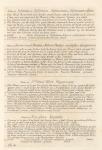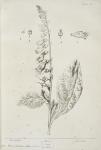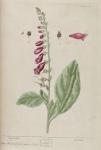

 13. Jasmine, or Jessamine. Jasminum or Jasminum album.
13. Jasmine, or Jessamine. Jasminum or Jasminum album.
1. This Shrub shoots forth long slender green Twigs, which would lie on ye Ground if they were not supported; the Flowers of the common Jasmine are white.
2. It is planted with us in Gardens, and flowers for several Months in the Summer.
3. The Flowers are the only Part used. Schroder commends them as good to warm & relax the Womb, to heal any Schirrthi therein, and to facilitate the Birth: and also for a Cough and Difficulty of breathing. The Oil made by Infusion of the Flowers is used in Perfumes. Matthiolus thinks that the Ointment made of Jasmine by the Ancients was not that Jasmine which we have now.
4. Greek. -. Latin, Jasminum or Jasminum album or Gelsiminum. Italian, Gelsimino. French. Jasmin. German. Beielreben. Dutch. -.

 14. Narrow-leaved Plantain, or Ribwort. Plantago angustifolia, or Quinquenervia.
14. Narrow-leaved Plantain, or Ribwort. Plantago angustifolia, or Quinquenervia.
Also see #014, Narrow-leaved Plantain - #035, Broad-leaved Plantain.
1. It grows to eight or nine Inches high; the Leaves have five Nerves which run quite thro' them from the Root; the Flowers are of a light Umber colour with white Apices.
2. It grows in Fields and Meadows and flowers mostly in May and Iune, altho' you may find some of it in Flower most Months of the Summer.
3. It is cold, dry and binding: good in all kind of Fluxes and Haemorrhages as spitting or vomitting of Blood, bleeding at the Nose, the Excess of the Catamenia or Lochia. It stops ye involuntary making of Urine, eases its Heat & Sharpness, & the Gonorrhea, & stops the bleeding of Wounds. The Officinal Preparation is, the simple distilled Water.
4. Greek, Αρνάγλωσσον μακρόν or παι τανδρος (I'm not at all certain that I've read this correctly). Latin, Plantago angustifolia & Quinquenervia. Italian. Piantagine longa or Lanciola. French, Plantain. German, Spigiger Wegrich. Dutch, -.

 15. St. John's Wort. Hypericum.
15. St. John's Wort. Hypericum.
Also see #015, St. John's Wort - #094, Tutsan.
1. This Plant grows to be two Foot high; the Leaves when held up against the Light appear full of small Holes; the Flowers are bright Yellow, with a great Number of Apices & Stamina, which being bruised between ye Fingers emit a bloody Juice.
2. It grows in Hedges and among Bushes, and flowers in Iune and Iuly.
3. St. John's Wort is accounted aperative, detersive, diuretic, alexipharmic; good in tertian and quartan Agues; destroys Worms, and is an excellent vulnerary Plant. A Tincture of ye Flowers in Spirit of Wine is commended against Melancholy & Madness. Outwardly it is of great Service in Bruises, Contusions & Wounds, especially in the nervous Parts. The officinal Preparations are, the simple and compound Oil.
4. Greek, Υπερικον. Latin. Hypericum or Hypericum vulgare. Spanish, Corajoncillo. Italian, Hyperico and Perforata, or Herba di S Giovanni. French. Millepetuis or Trucheran. German, Sanct Johannicraut. Dutch. -
1. It grows to be three Foot high; the Leaves have a little Down upon them; ye Flowers are red, spotted with white, and grow all on one side of the Stalks.
2. Fox-Glove grows in Hedges and Lanes, and flowers in Iune and Iuly.
3. This Plant is but rarely used inwardly, being a strong Emetic working with Violence upwards and downwards. Parkinson extolls a Decoction of it in Ale, with Polipody Roots, as an approved Medicine for ye Falling Sickness. The late Doctor Hulse commends ye Ointment made of the Flowers and May Bitter, for Scrophulous Ulcers which run much, dressing them with the Ointment and purging two or three Times a Week with proper Purges. The officinal Preparation is the Unguentum digitalis.
4. Greek, -. Latin, Digitalis, or Digitalis purpurea. Spanish, -. Italian, -. French, La Digitale. German, -. Dutch, -.



